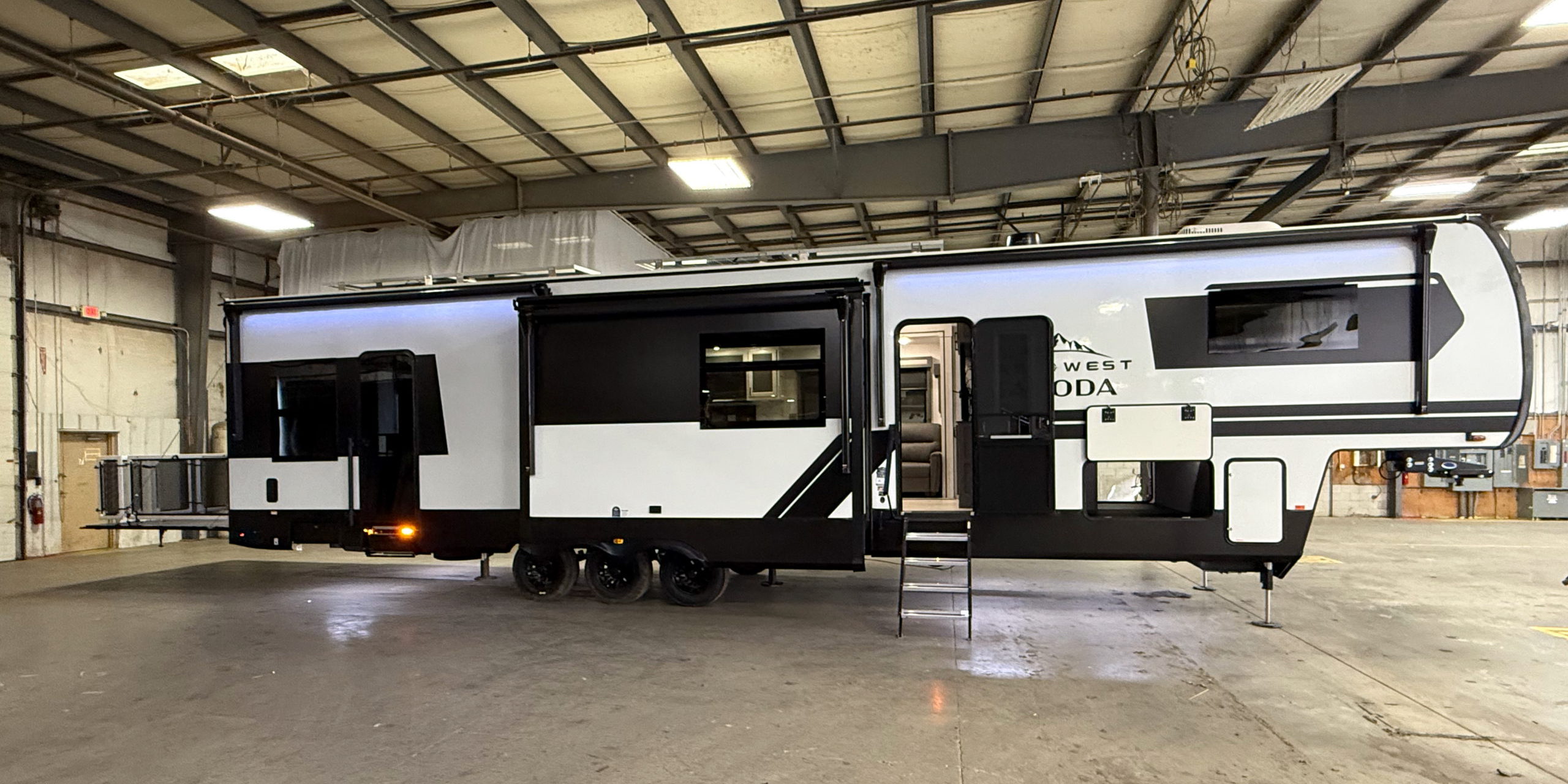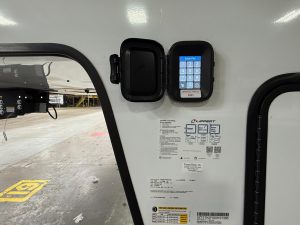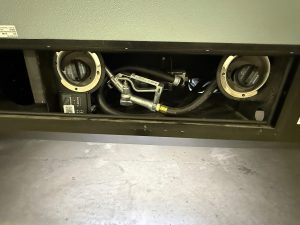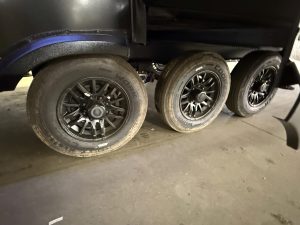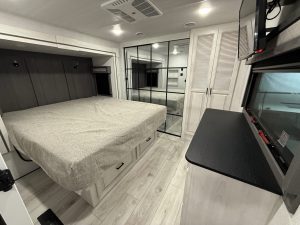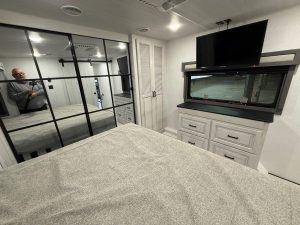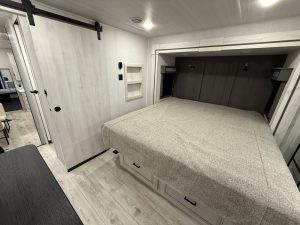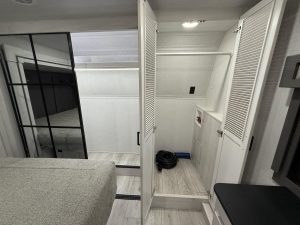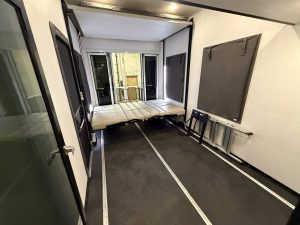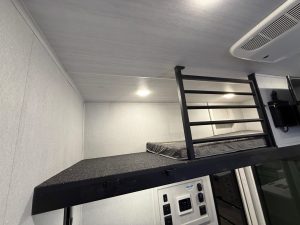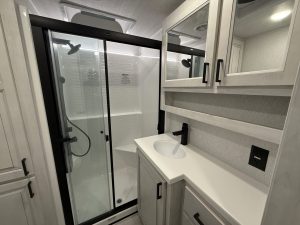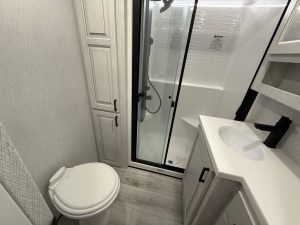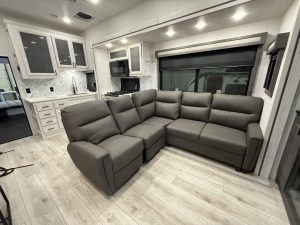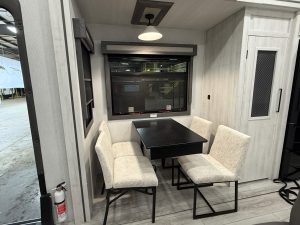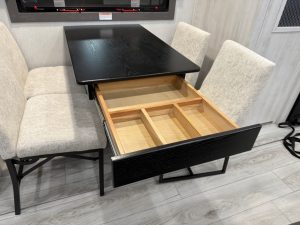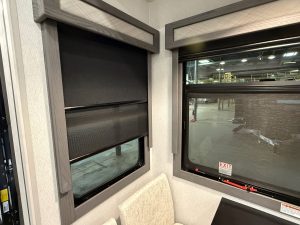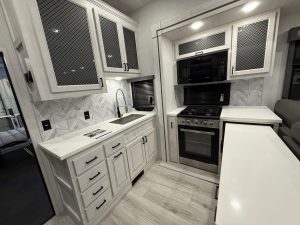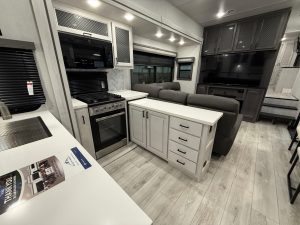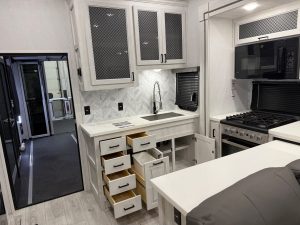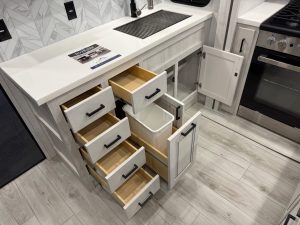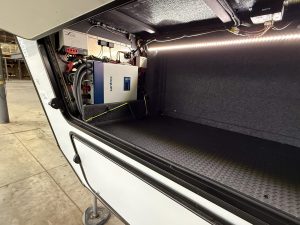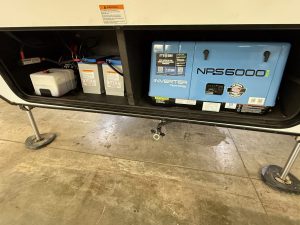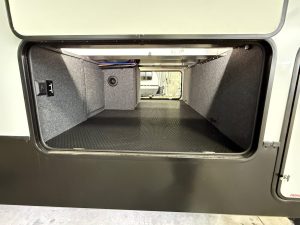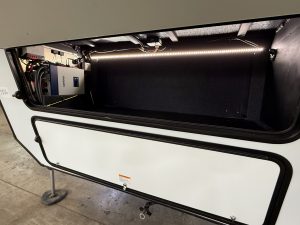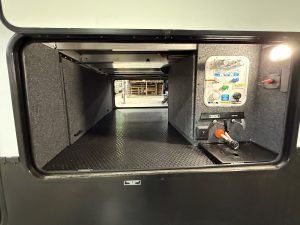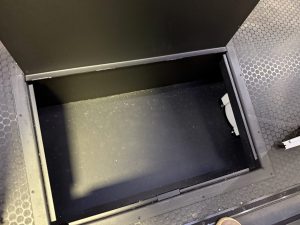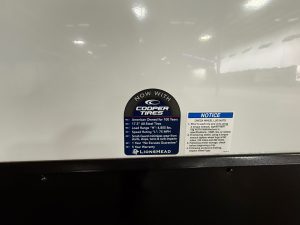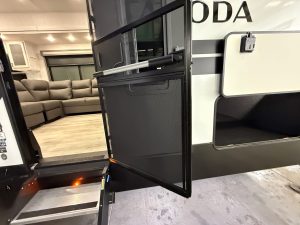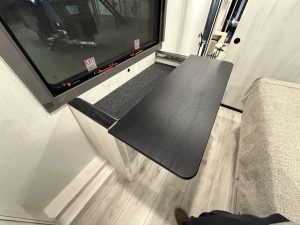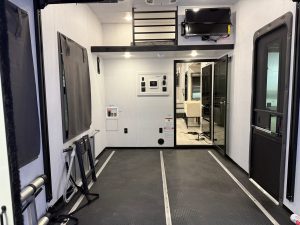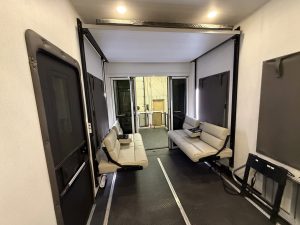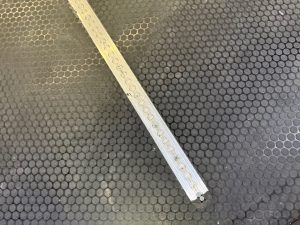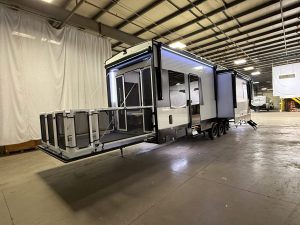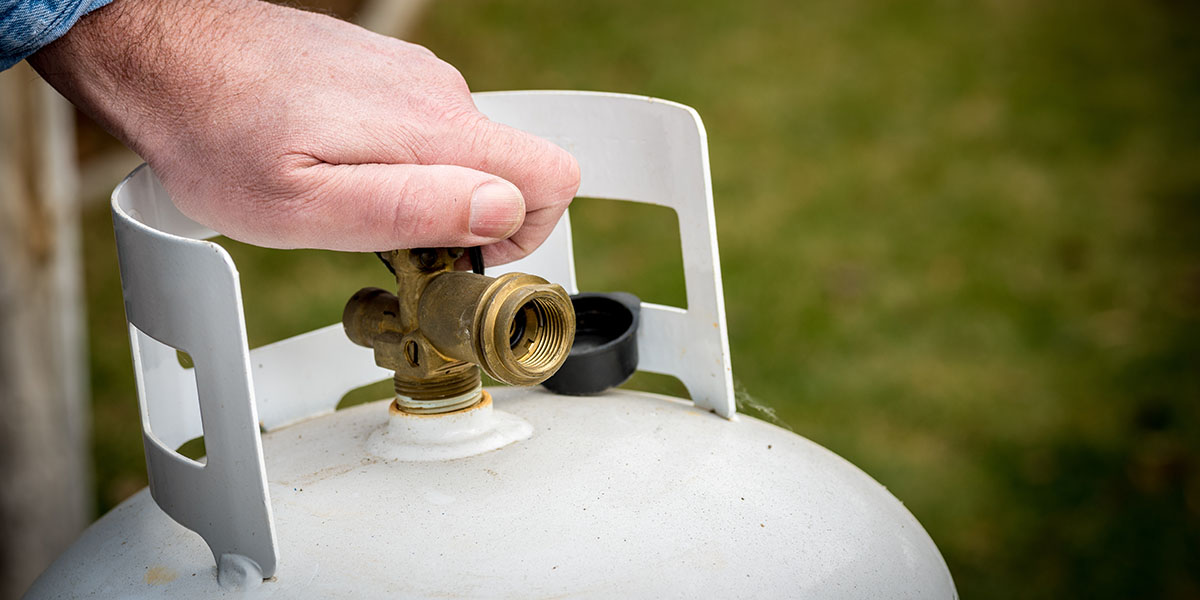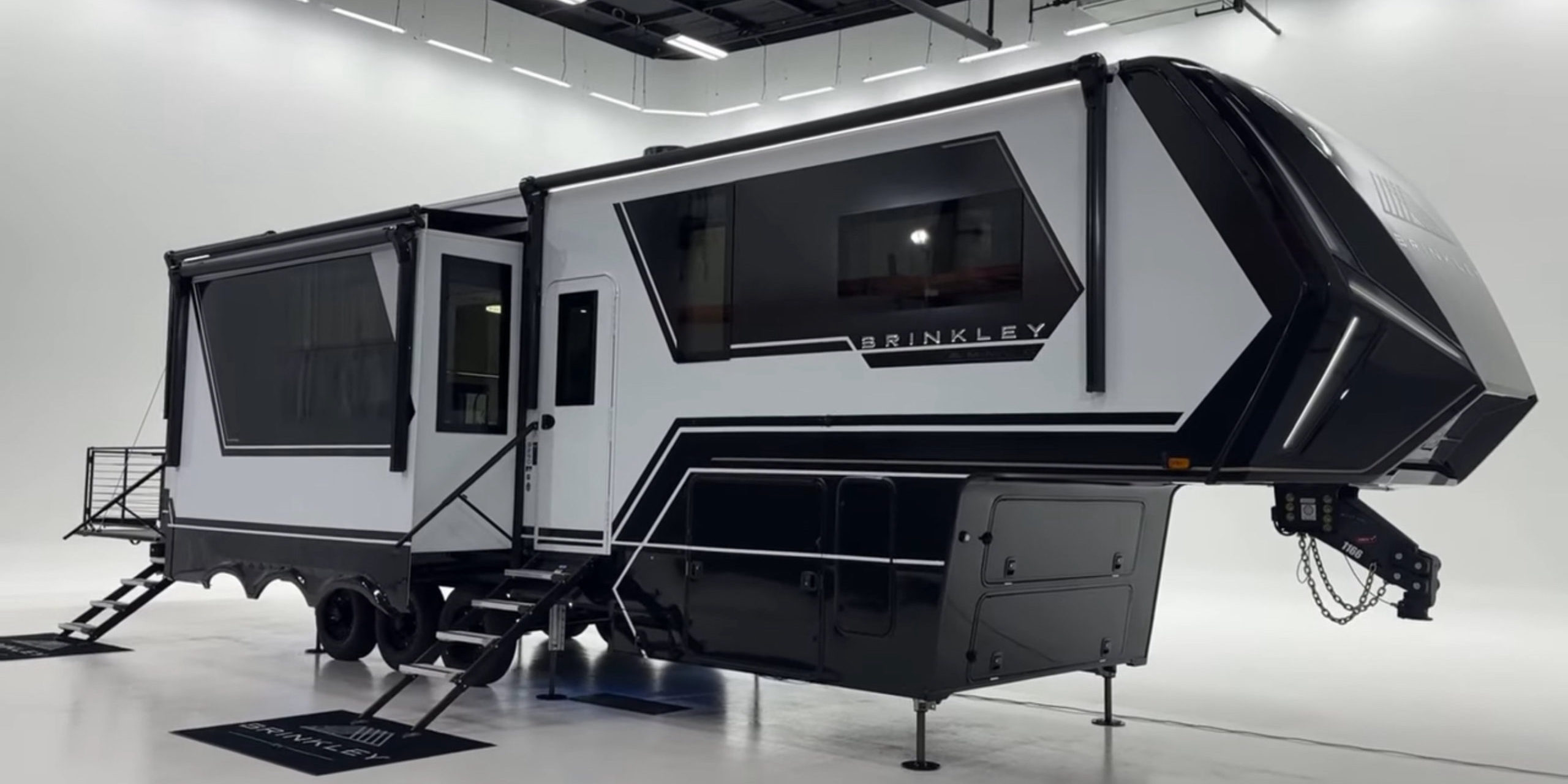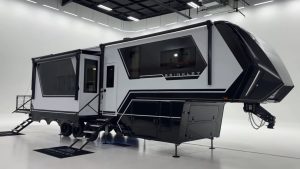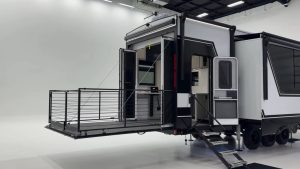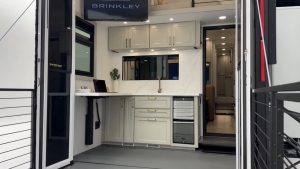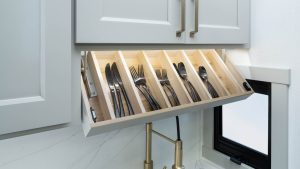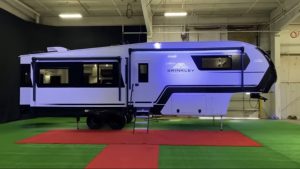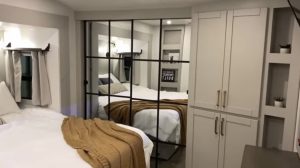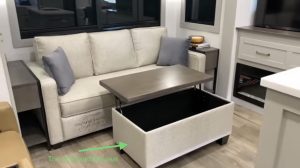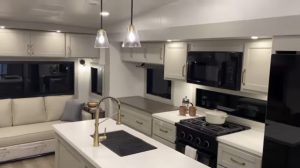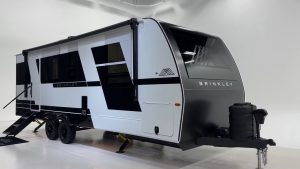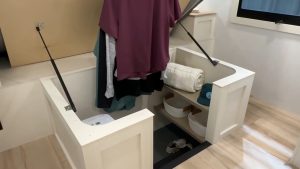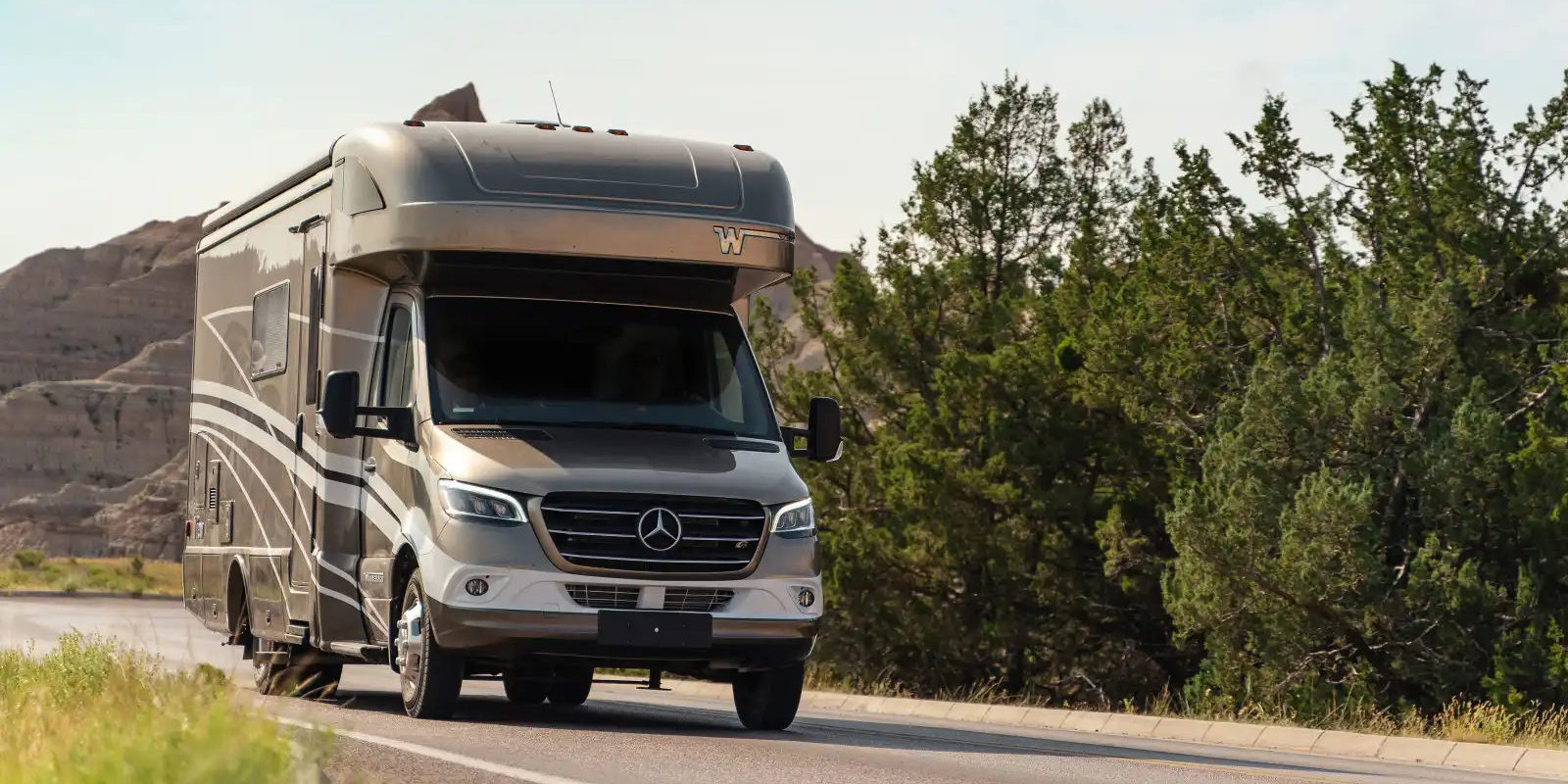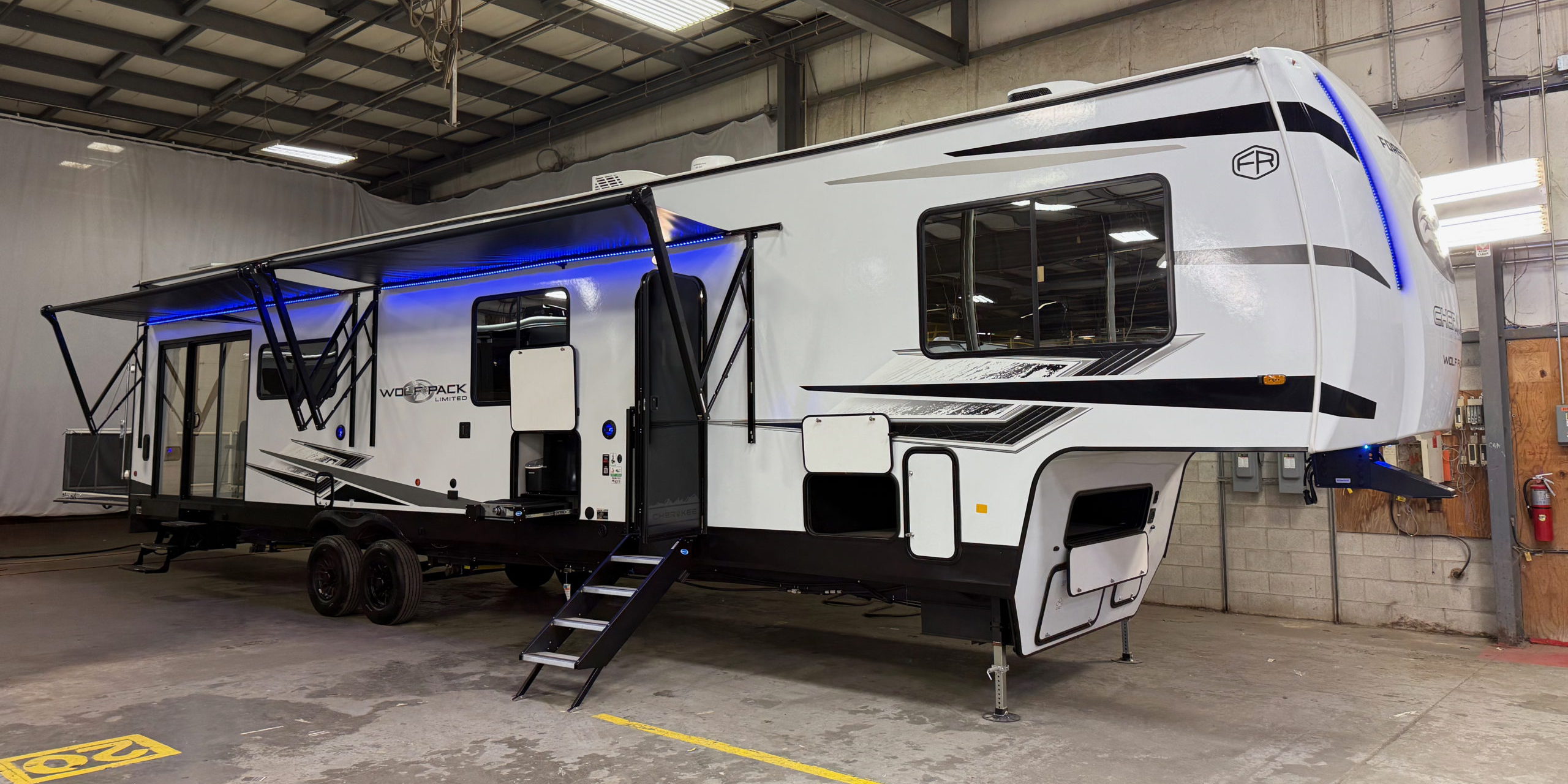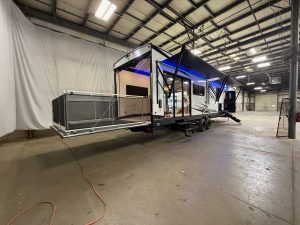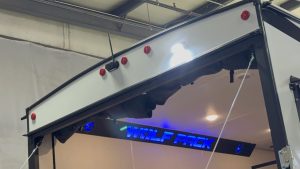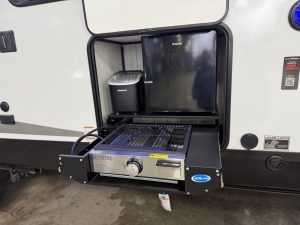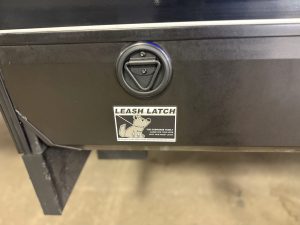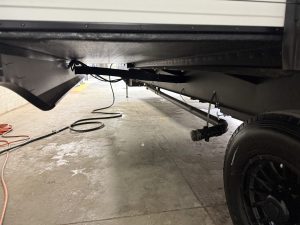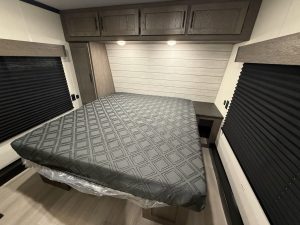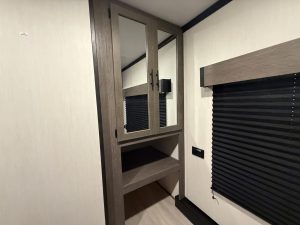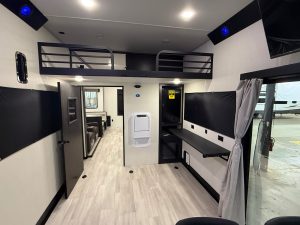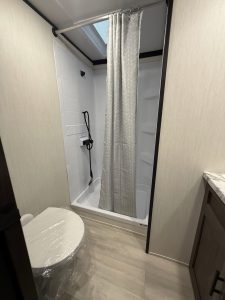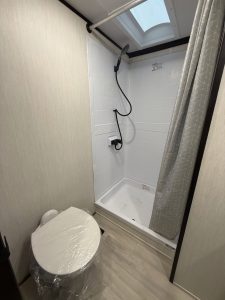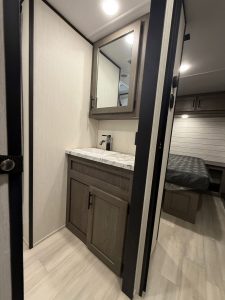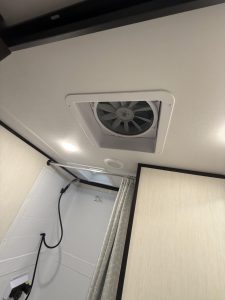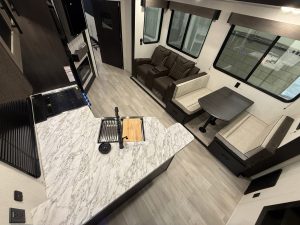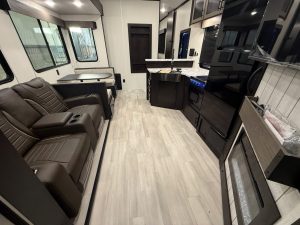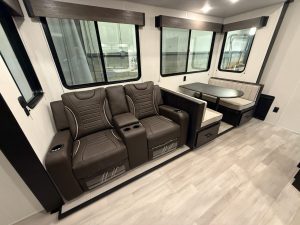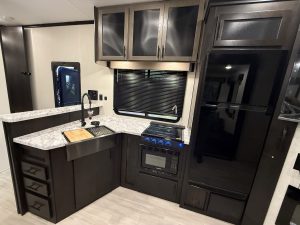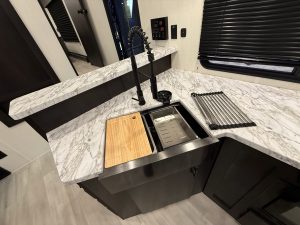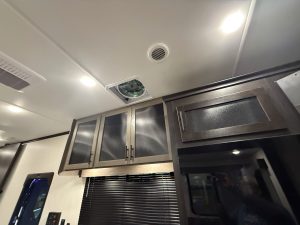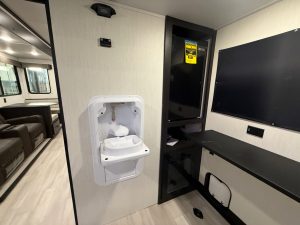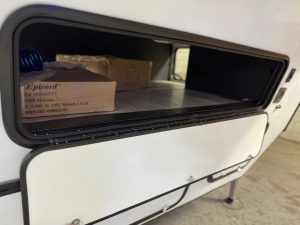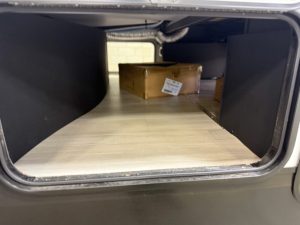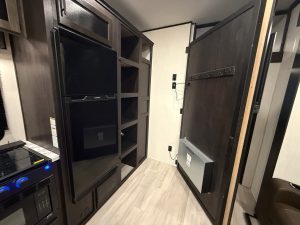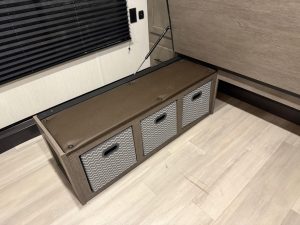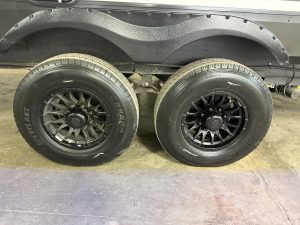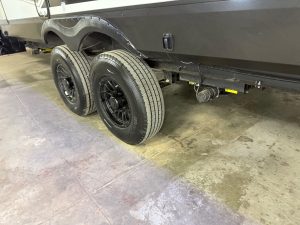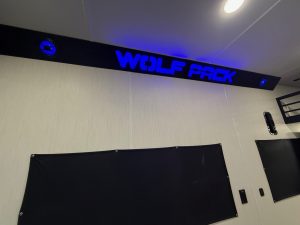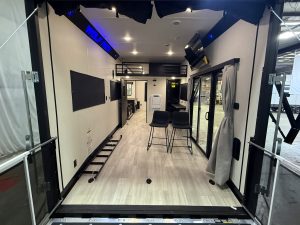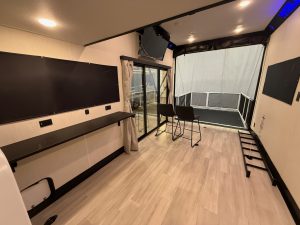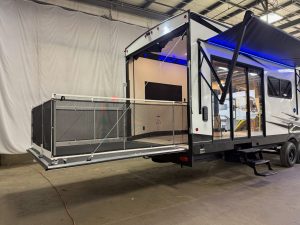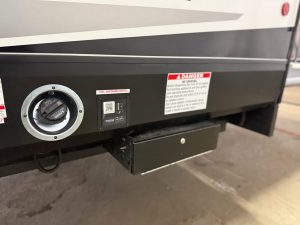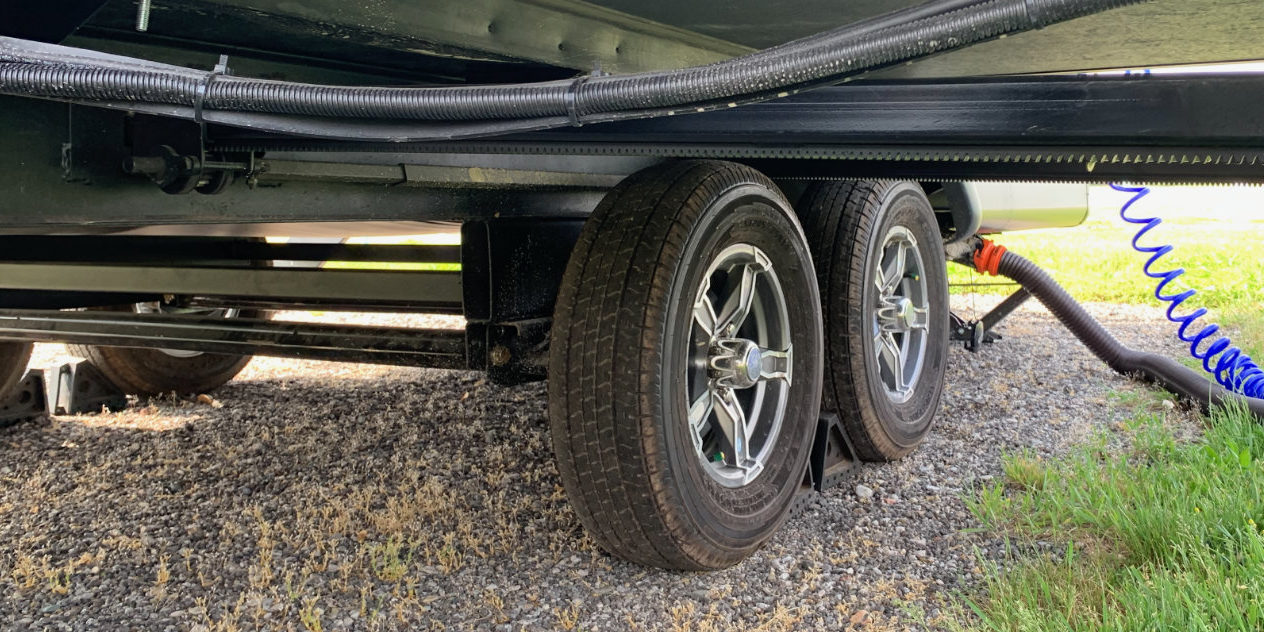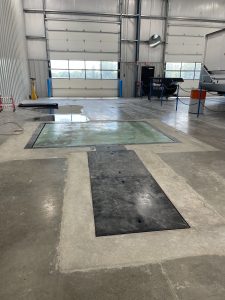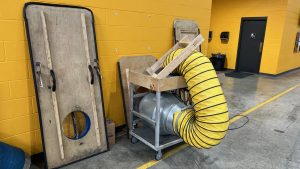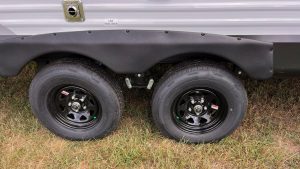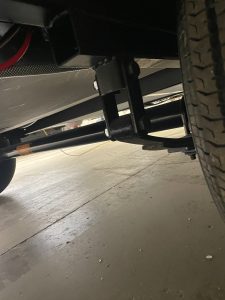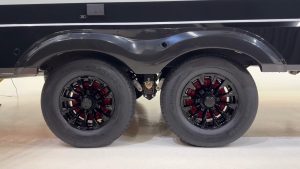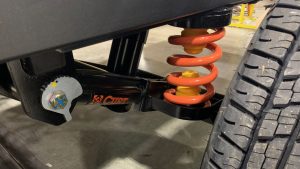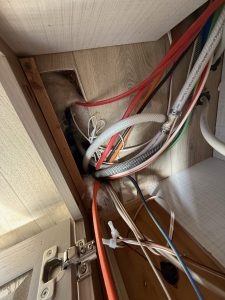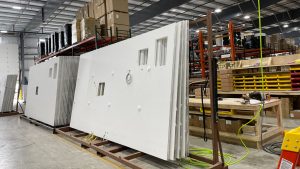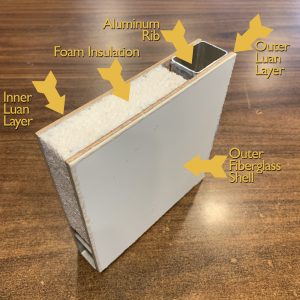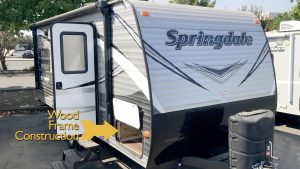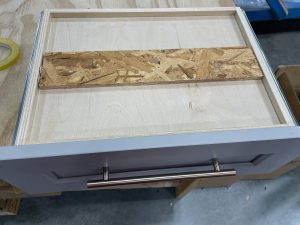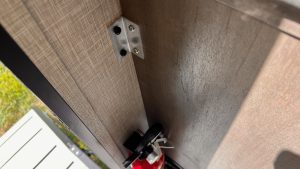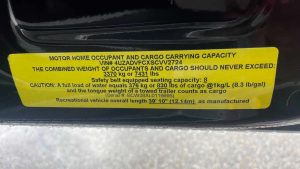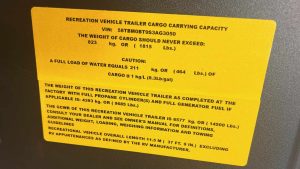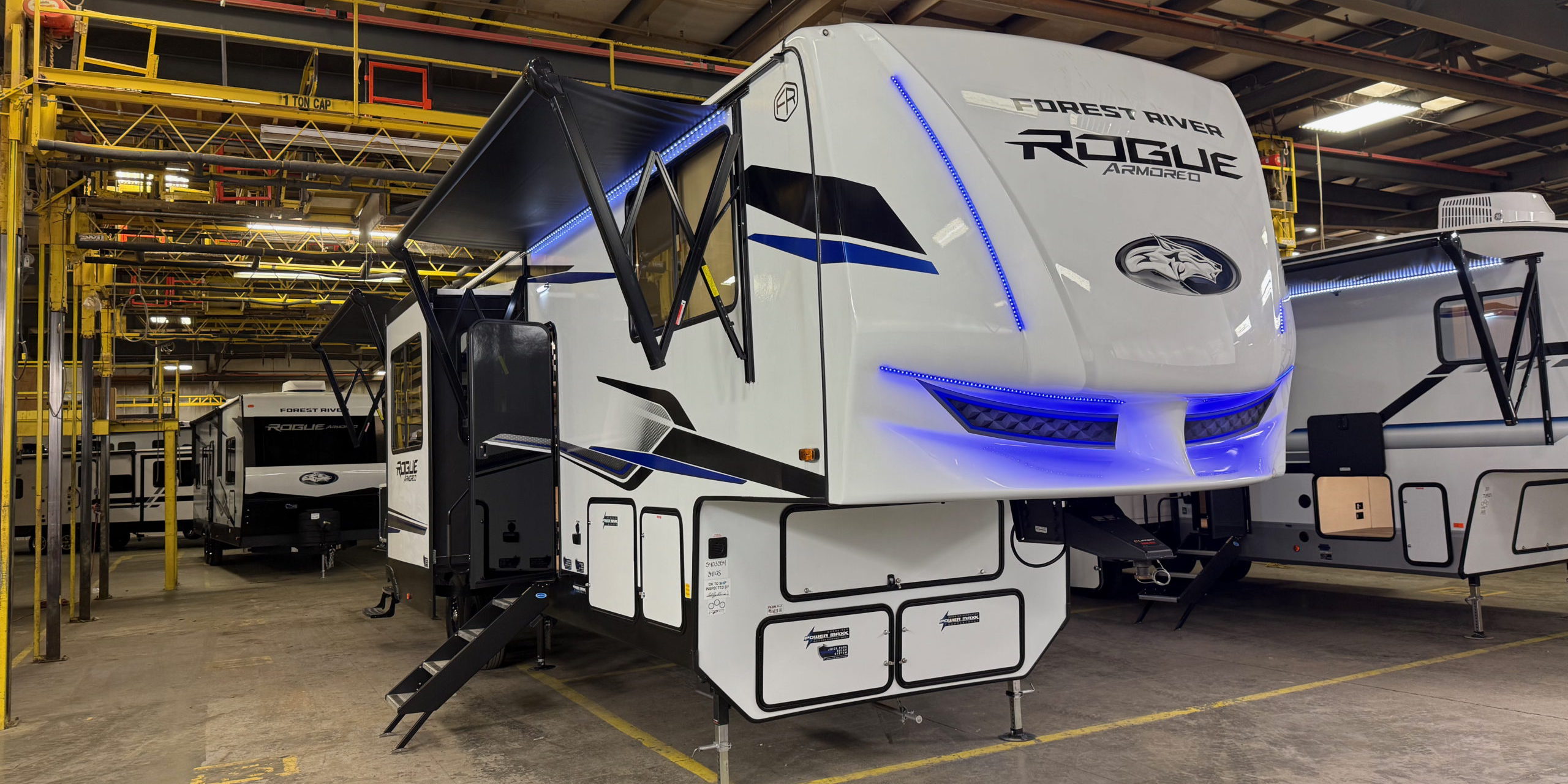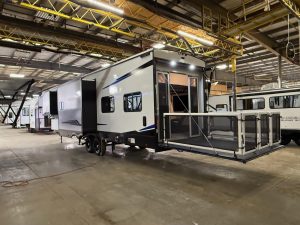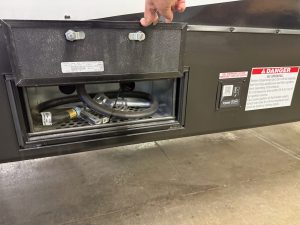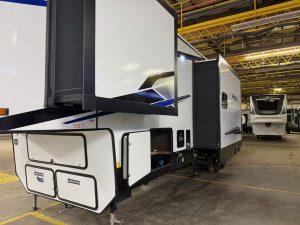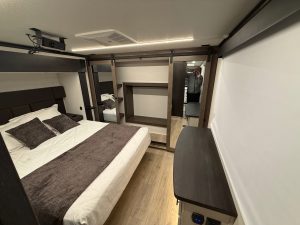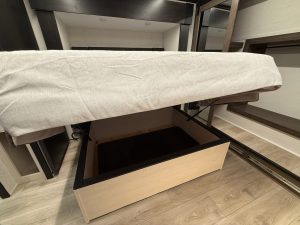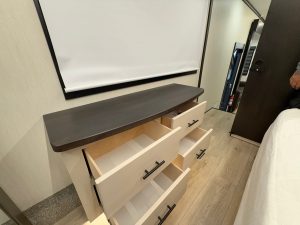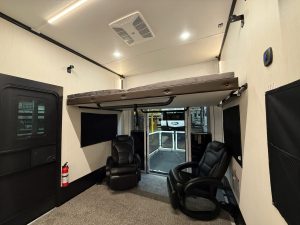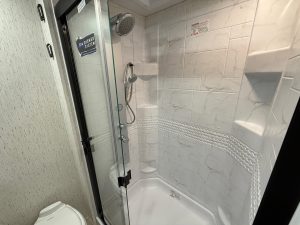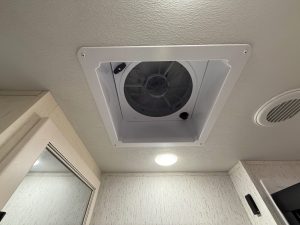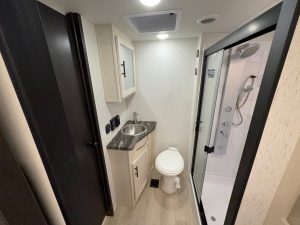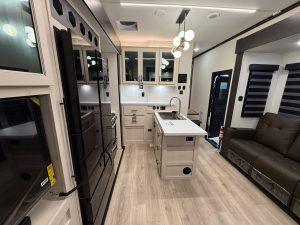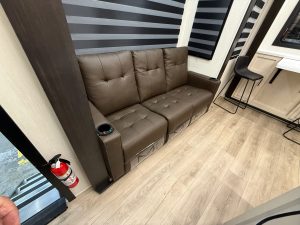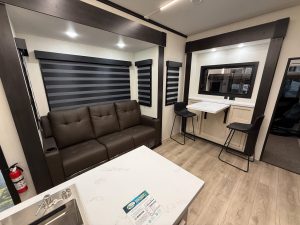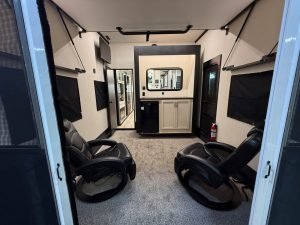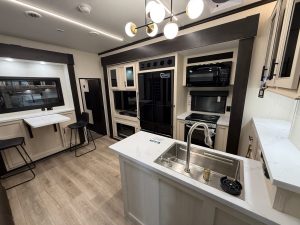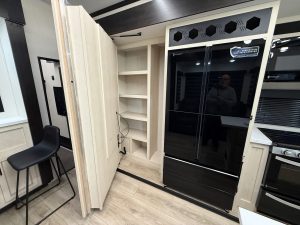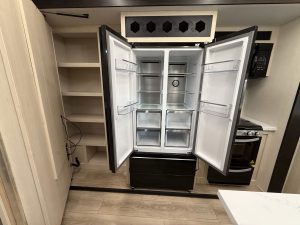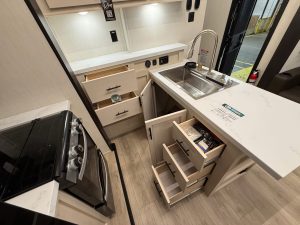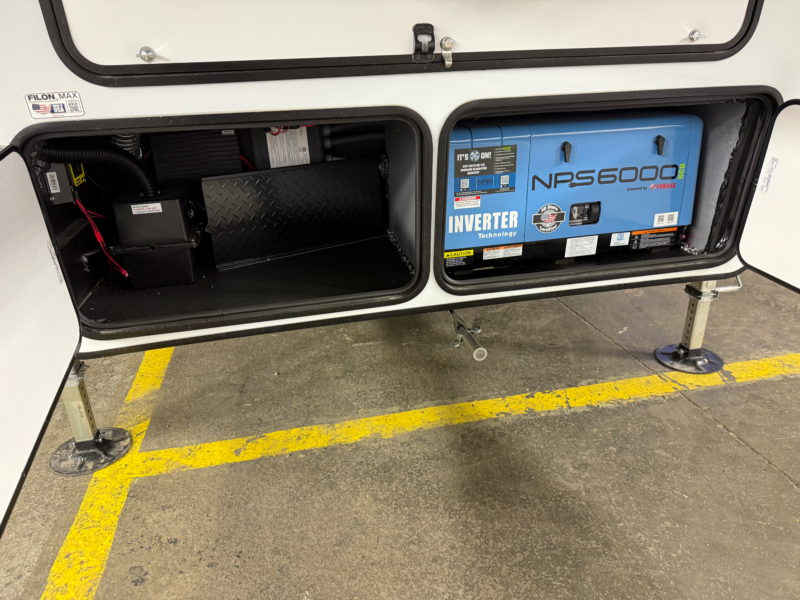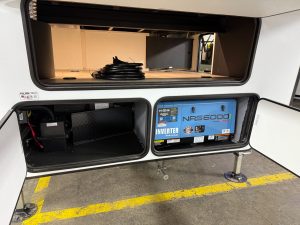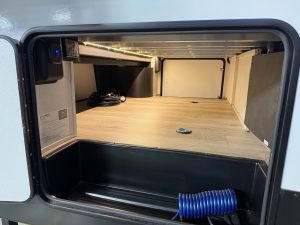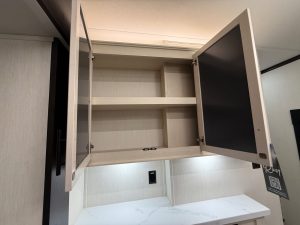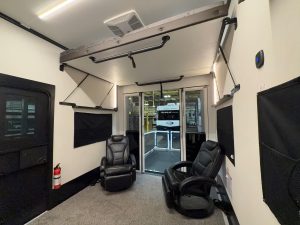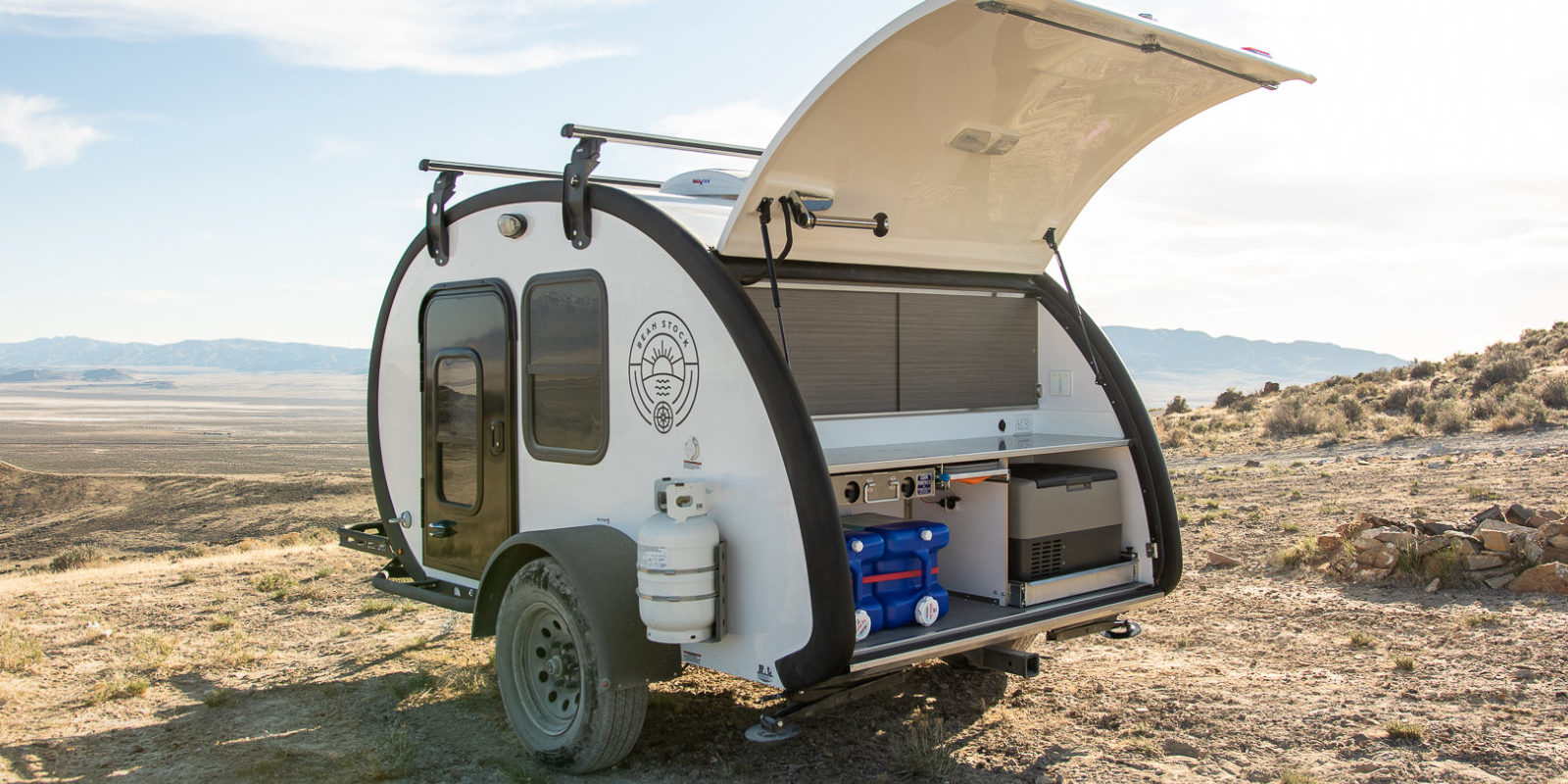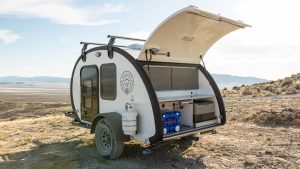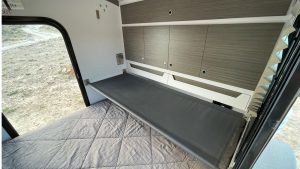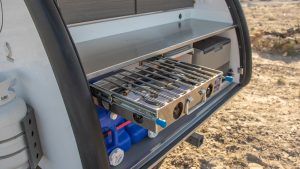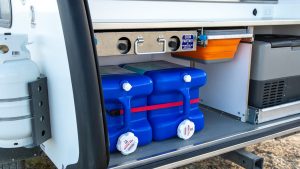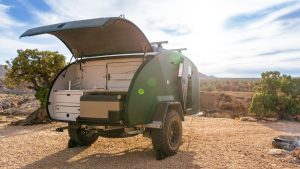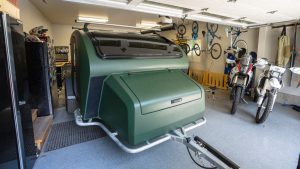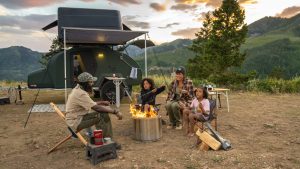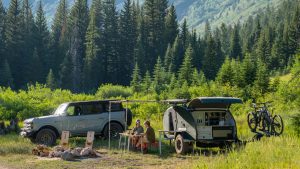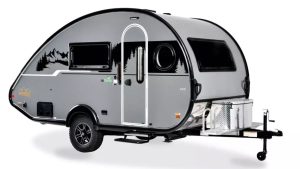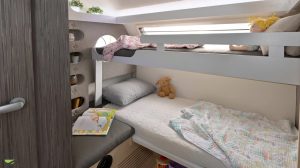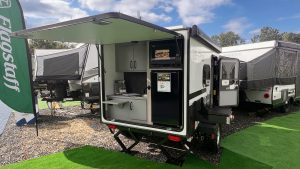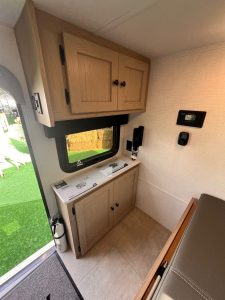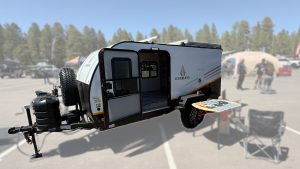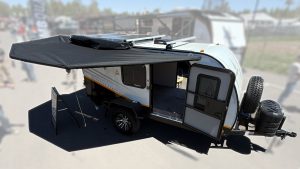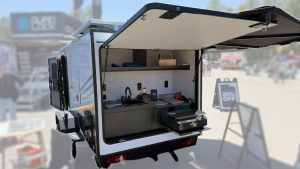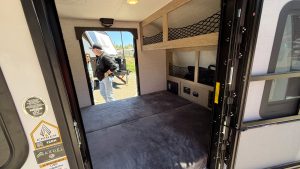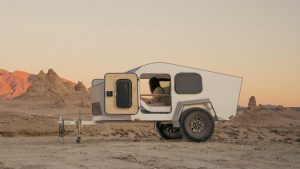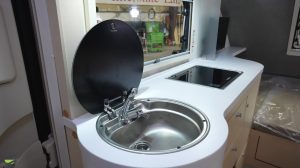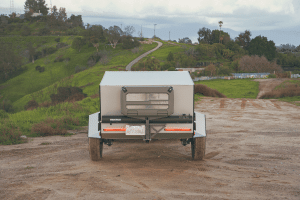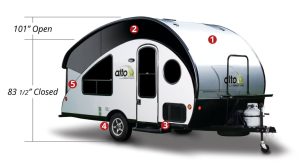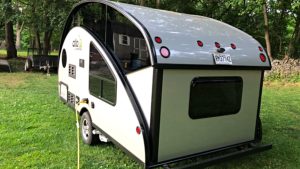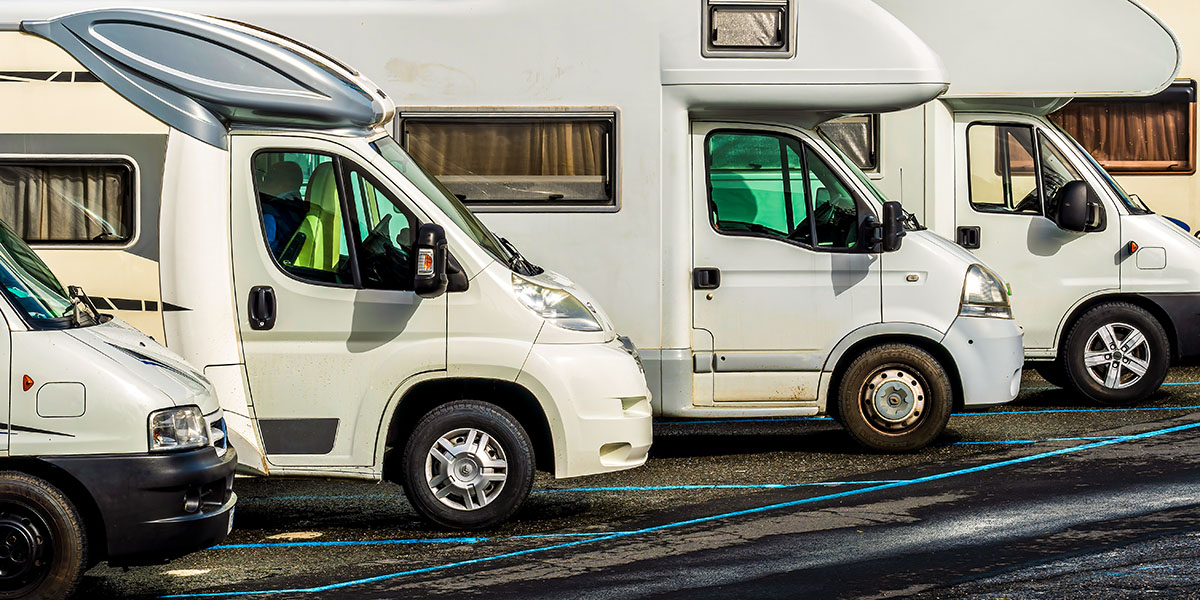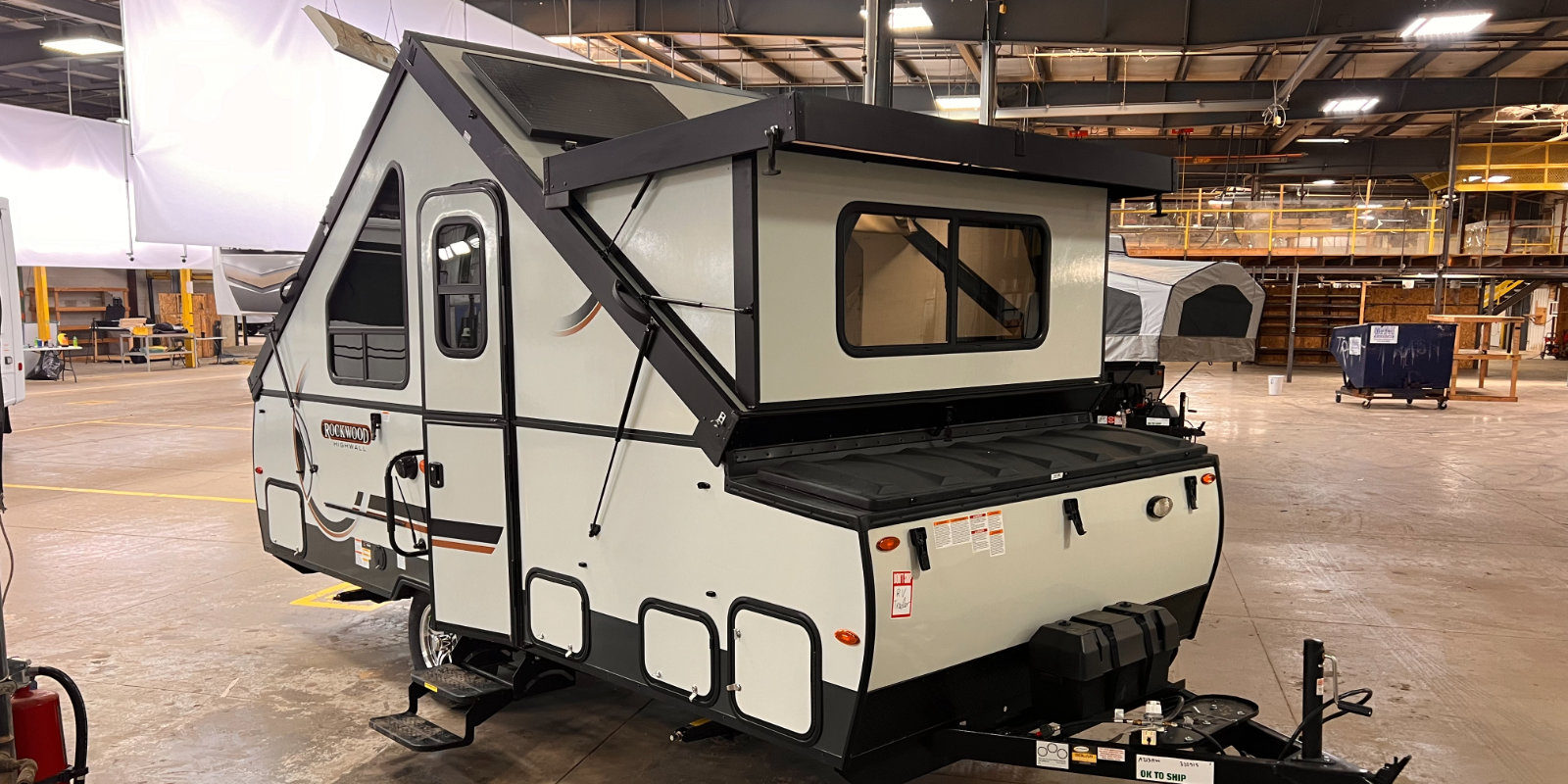For some toy hauler buyers, compromise simply isn’t an option. Not for cargo capacity and not for comfort. And if you fall into that class of buyer, you are going to love what you see in the 2025 East to West RV Takoda 399TH. Because this fifth-wheel toy hauler is going to be tough to beat.
Attention to detail is a strong suit of the Takoda 399TH. You see it in the features, the build quality, and the cold and hot weather protection. Often, many RVers buy a next rig and then upgrade things to their liking. But the design of the Takoda 399TH thinks so far ahead that it’s tough to find an aspect of this RV that needs an upgrade.
So, let’s talk about some of those details.
At a Glance: Takoda 399TH
I rated the Takoda 399TH 8.7 out of 10 — a very high score. This ambitious toy hauler combines a flexible use case with a very pleasant interior, off-grid and cold camping capabilities, and an impressive build quality. As already mentioned, the attention to detail distinguishes this model as a high-end option in the field of large toy haulers.
[review_summary class=”custom-class” title=”2025 East to West RV Takoda 399TH” description=”This score is awarded by an expert reviewer conducting an independent assessment of the RV.”]
Check the Specs
- Sleeping capacity: 9
- Hitch weight: 3,265 pounds
- UVW: 17,389 pounds
- CCC: 3,611 pounds
- Exterior length: 47 feet
- Exterior height: 13 feet 4 inches
- Exterior width: 102 inches
- Fresh/Gray/Black: 150/88/44 gallons
- Propane: 2 x 30-pound tanks
- Awnings (4): 16 feet; 10 feet 9 inches (x 2); and 8 feet
- MSRP: $176,314 (estimated)
Features We Love
- Massive 14-foot garage
- Three-season patio doors plus patio deck
- Frameless square windows that require low maintenance
- Premium interior feel and features
- Off-grid functionality: 860-watt solar system (4 x 215-watt solar panels), 3,000-watt inverter, MPPT solar controllers (2 x 50-amp), lithium batteries (2 x 200-amp hour)
- Large, 150-gallon freshwater tank
- Winter-ready features: Heated and enclosed holding tanks, 2-inch thick laminated walls, heating pads
- Three (3) air conditioners
- Backup and side view cameras standard
- High performance reverse lighting standard
- Smart autolevel system
- Built-in air compressor
Benefits
Garage Stuff
- Massive and masterful garage. As you’d expect, the 14-foot garage on this trailer plus cargo carrying capacity make it well suited for those who want to carry larger toys. For this, the Takoda 399TH is top notch. With the click-track system in the floor, loading and securing that load is a strong suit of this RV. Further, the locking tool box in the floor of the garage adds the ability to stow straps and tools to make the job of securing the load easier.
- Pet- and kid-friendly patio deck. The ramp door on this trailer features a surround that forms a fence of sorts plus a provision to set the door horizontally. So, you can use the ramp door as a patio deck. There is also a glass patio door with bug screens called a three-season door so you can go in and out. This makes a great place for entertaining, particularly if you’re camped somewhere with a great view. These are also good to contain pets or smaller children which allows them to go in and out but still staying within the confines of the camper.
- Onboard features for toys. The onboard fueling station with two 30 gallon tanks would enable someone to fill gasoline-powered vehicles like motorcycles, ATVs and the like so they could be transported with little or no fuel aboard and simply gassed-up at the destination. Also, having an onboard compressor can enable inflating things like water toys, mattresses, tires and more. This is a great feature in any RV but especially useful in a toy hauler where you may want to inflate/deflate tires on off-road vehicles based on conditions.
Beyond the Garage
- Fifth-wheel luxury. The interior of the Takoda 399TH has a very premium feel and features throughout — not typical of toy haulers. The kitchen itself is exceptional.
- Off-grid camping. The solar power system on this rig is massive and impressive. But just as impressive is the large water tank. Realistically, lack of water brings just as many boondockers home as lack of power. The Takoda 399TH stacks the deck in both areas.
- Safe and smart features. With three cameras on this RV, one for each side plus one in the back, it makes moving an RV of this size an easier and safer operation. Additionally, the smart level system enables automatic leveling but will also remember the height of the pin/nose of this trailer when it comes time to hitch it back up to the tow vehicle.
Challenges
- Towing — and parking — this giant RV. The single biggest benefit of this RV, its large size, is also its greatest challenge. The Takoda 399TH is 47 feet long. There are absolutely places where this simply won’t be able to fit. Further, at a gross weight of 21,000 pounds it will take a significant tow vehicle to move this around.
- Recommend upgrading to disc brakes. While I was happy to see MORryde CRE 3000 suspension dampeners and quality Cooper tires, nevertheless I would recommend upgrading to a disc brake system for safety with an RV this large.
Best For
- Toy hauler shoppers looking for a larger and more versatile cargo space. An RV with this flexible an open space is also a great choice for those who work on the road or have hobbies that might be made more enjoyable in a larger, open space.
- RV owners who want to play hard outside and enjoy luxury living inside. Especially with a large crowd. There is the main sleeping space … plus a fold-out couch in the main living space … plus the beds in the cargo bay, this could be a great choice for those who are in competitive sports to bring the entire team and the vehicle(s) used to participate in those sports.
- Campers who love to cook. I’ll talk about this more, but I’m not sure I’ve seen a better RV kitchen.
- Off grid and all-weather campers. The Takoda 399TH is fitted with a robust suite of off-grid sustainability features and cold-weather capabilities that mean it’s up to the all-weather challenge.
Key Areas We Evaluate for RV Buyers
Sleeping Space: 9/10
There are really three separate zones for sleeping in the Takoda 399TH. Up front, over the pin box, is a large bedroom with a king-size bed in a slide. In the bedroom, there is a closet that spans about two-thirds of the width of the trailer. This closet also has a hanging rod that is a motion-activated light. It’s really convenient. Further, there is a second closet that occupies the other one-third of the space. This space could provide additional hanging storage, but it is also fitted with washer-dryer hook-ups.
There is also a four-drawer cabinet in the bedroom of the Takoda 399TH. All the drawers in it incorporate soft-close mechanisms and are very nicely finished inside. The top of this cabinet also slides open to reveal a shallow hidden storage well. The sliding mechanism also means that any items placed on the cabinet don’t have to be moved to open the cabinet.
Sleep Zones Outside the Bedroom
The second zone would be the main living space which has a large L-shaped sofa that has a fold-out bed for two. Lastly, the third sleep zone is in the cargo area. There is a bed-lift mechanism (HappiJac) with a second larger bed and opposing couches that can be yet another bed. While these two sleeping spaces have thinner cushioning owing to the fact that they can be lifted up against the ceiling, they still would work for adults or children. Alos, there is yet another bed in a loft in the sleeping area that might be best for younger travelers but could accommodate an adult in a pinch.
All these spots combine to accommodate nine people.
Bathroom: 9/10
Every aspect of the Takoda 399TH has a very premium feel. That includes the bathroom, which is on the upper deck of this fifth-wheel toy hauler. In here, there is plenty of space to accomplish the tasks one would want to accomplish but also enough room to change clothing. There is also a good amount of linen storage in closets with adjustable shelves.
The shower is a larger walk-in type typical of a fifth wheel with an elaborate spa-style showerhead and seat molded into the fiberglass enclosure.
Living Area: 9/10
Toy haulers often get criticized for being spartan-feeling. The Takoda 399TH is anything but. The finish and materials in this RV provide a very premium feel — including the large, L-shaped sofa which faces an absolutely enormous TV. (There’s also a large fireplace.)
The Takoda 399TH also includes a table and chairs. The table itself is wall-mounted. (This helps you to avoid knocking your knees.) It also incorporates a drawer for silverware built right in the table. The premium feel of this space extends to the window treatment, which encloses both roller night shades and day shades that screen-out much of the sunlight.
Kitchen: 9/10
The kitchen in the Takoda 399TH is nicer than the one in my house. It contains a lot of cabinetry and drawers, including a drawer with a provision for a trash can. The cabinets and drawers all have soft-close mechanisms. This adds to the upscale feel, as do the very nicely finished interiors.
The stove and microwave are GE Profile brand, which are comparable to those in most houses in space and functionality. For cold food storage, there is a large French-door, 12-volt refrigerator with two freezer drawers. Again, it’s as nice — or nicer — than what you’ll find in a lot of houses.
In terms of regular storage, there is a pantry that has two additional drawers and plenty of space. If you find the rest of the kitchen’s drawers and cabinets are sufficient, this could also be used for clothing storage for all those people this RV can accommodate.
For RVers who love to cook, I don’t think there’s a better RV kitchen out there. Plus, there is a very large amount of countertop space to boot. (Which would be great for serving a buffet to your race team, assuming that’s what you’re using this trailer for.)
Four-Season Capabilities: 10/10
With all the other traits of this RV, its ability to weather seasons is another highlight. There are two-inch thick laminated walls, an enclosed underbelly (that’s also heated), plus 12-volt heating pads on all the holding tanks. Even the cargo compartment at the front has a furnace duct. So that space is heated as well.
Once winter is over and summer begins, there are three air conditioners on this RV to keep things cool. Sure, those require a lot of power, but that brings me to my next thing.
For those who want to spend time off-grid, this is an excellent choice. The unit includes a built-in 6,000-watt generator but also includes two substantial 200-amp-hour lithium batteries. There was 860 watts of solar on the roof and a 2,000-watt inverter. This is the best of all worlds. You get a significant solar system that can supply two large batteries with plenty of power and may be sufficient for a lot of off-grid camping. Then you have an onboard generator and two 30-gallon fuel tanks. There is no situation where you won’t have enough power to sustain this beast even when the closest hook-ups are in the next city.
There are a lot of RVers, myself included, who have spent a lot of money on solar and lithium systems to achieve this kind of off-grid living. It comes standard with the Takoda 399TH and then adds a huge generator on top of that.
Storage Space: 9/10
Of course, the most obvious storage spot in the Takoda 399TH is the very large garage. (This is, after all, a toy hauler.) But there is also a rather sizable storage bay in the front of this RV, common in most fifth wheels. That space is also heated and has motion sensing lighting in it. That, coupled with the space found in the bedroom and living area is rather robust indeed.
Chassis/Suspension: 7/10
I like that East to West RV includes the MORryde CRE 3000 suspension dampeners as part of the build. These help minimize vibration being transmitted into the cabin as the RV rolls down the road. This protects the RV itself and makes towing a nicer experience. This system also incorporates what are called wet bolts which can be greased which extends their lives.
This is the first time I’ve seen Cooper tires on a towable RV, and I’m familiar with the brand as being a quality product. These tires are also made in the USA, which earns points with me.
Speaking a little more to the rating I gave the chassis (a score of 7), you can choose to upgrade the system to a disc brake system. And I couldn’t be more enthusiastic about doing so. On a rig this large, that option is a safety upgrade that I feel is well worth making and that would elevate the rating to a 9 in my opinion.
Build Quality: 8/10
There are a number of new RV components coming on the market for builders of RVs and one of those are new square windows. These are of the frameless variety, which means they require lower maintenance. Inside, these windows are both day rollers shades and light-blocking roller shades.
At times, RV companies include nicer features in their rigs, but those RVs do not always show great consistency in build quality. However, the Takoda 399TH has no such dilemma. Evidence is everywhere from very nicely finished drawers to little build features that demonstrate a meticulous a attention to detail. It’s clear that East to West RV did a good job with the build quality. Another example of build quality is the dovetail drawer construction, which is very uncommon in RVs. (It’s the best way to make drawers, in my opinion.)
Garage: 9/10
One of the most obvious reasons to buy a toy hauler is the garage. The Takoda 399TH is a full 14 feet in length. But, more than that, there are three tracks in the floor that allow you to tie-down the things in the back of the trailer. These tracks use an industry-standard track system. There is also a locking toolbox in the “beaver tail” portion of the garage — where it slopes down to meet the ramp. This is a pretty sizable storage bay and can be locked. Great for putting things like tow straps and tools out of the way.
Funny thing: There are hook-ups for laundry in the upper bedroom in a closet, but then there are additional hook-ups here in the garage of this rig. In theory, you could have two washers and two dryers. (Although I doubt anyone would unless they’re using laundry service as a way to make a few extra bucks on the road.)
Rearranging the Space
There is a power lift mechanism, called a HappiJac system, that lifts the upper berth to the ceiling when it’s time to load-up. There are also opposing couches that also ride this chain-driven mechanism to go against the berth when it’s lifted. Now, we each have what serves us well, but admittedly, I just get impatient watching these things slowly move their way up toward the ceiling. Again, a very common system and one that allows the couches to also be a bed and allows six individuals to sit facing one another which makes game nights or meals more pleasant.
Value: 8/10
Once an RV gets to this lofty price range value can really be something to scrutinize. Some RVs are just fancy, but the Takoda 399TH provides a lot for the money.
For example, there are two gasoline tanks rather than the usual one. And there are a lot of other examples of notable attention to detail, including outside motion sensor lighting in places like above the fueling station. (A nice touch.)
I also liked that there was the screen protector for those who have pets, and there was also an additional little handle on the screen. It’s not like these small details add too much financial value, but they demonstrate how the decisions were made on this RV. Where possible, it seemed that East to West RV prioritized a feature that added convenience or quality to the rig.
Another detail that will play-out over time is the inclusion of the power cord reel, which is nice with a hefty 50-amp cord. I also liked the motion-sensing light in the upper closet as well. Again, little things but lots of examples of attention to detail. A few of the other included niceties were the built-in air compressor. (And let’s not forget the solar and lithium system and generator.)
Sometimes, certain RVs that I look at have a few nice features, but as a whole, that RV may not be well thought through. In this case, the detail under the skin translated into a well-designed high-quality RV.
Closing Notes on the Takoda 399TH
There was so much to like about the Takoda 399TH — the fit and finish, the features, and just a lot of examples of … you guessed it … attention to detail. While some toy haulers have an industrial feel, this one leaves that more practical function to the garage, closing it off as a separate space.
The main living areas of the Takoda 399TH are as upscale as in any fifth wheel. But there were other things to like. The power cord reel makes handling the fat, 50-amp power cord easier. Then there’s the built-in retractable water hoses, the motion-sensing lighting on the outside and in various interior compartments, the full camera suite including side-view cameras, and more. Further, this RV is well-suited for upscale RV parks. It also equally capable of boondocking far away from others with top-notch off-grid functionality.
Also, lots of campers who are pet owners upgrade the screen door on their RVs with a mesh protector on the lower portion. No need here. That and a screen assist handle are also included.
The obvious challenge of an RV of this size is simply the size alone. At 47 feet in length and with a 21,000 pound gross weight, the Takoda 399TH is massive. But for those who need something this large — and also want to live large — this rig is right in their wheelhouse.
A Note on the RV Trader Review Process
RV Trader asked RV shoppers what was most important to them in their RV buying process. Potential buyers — like you — helped us to identify a list of six key areas that camping and travel enthusiasts always look at when they’re searching for the perfect RV: sleeping space, bathroom, living area, four-season capabilities, and storage space.
The RV Trader team then got to work providing you with honest and unbiased evaluations. If you’re wondering, that’s where I came in. As an RV expert and enthusiast, I provide an honest look at RVs from an RV industry insider perspective.
Make Your Move
Start shopping for the year, make, and model. Find Your Takoda
What Other Campers Are Saying
Read the best reviews by owners. Search for an RV Model
